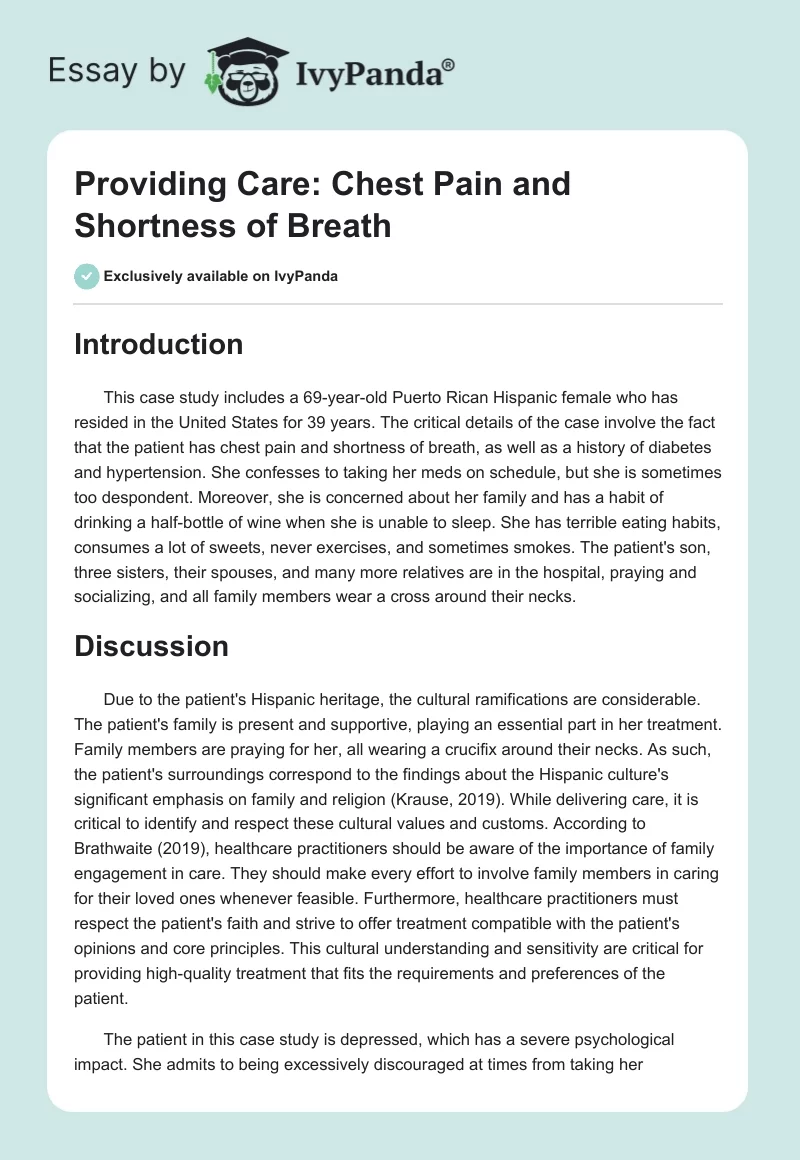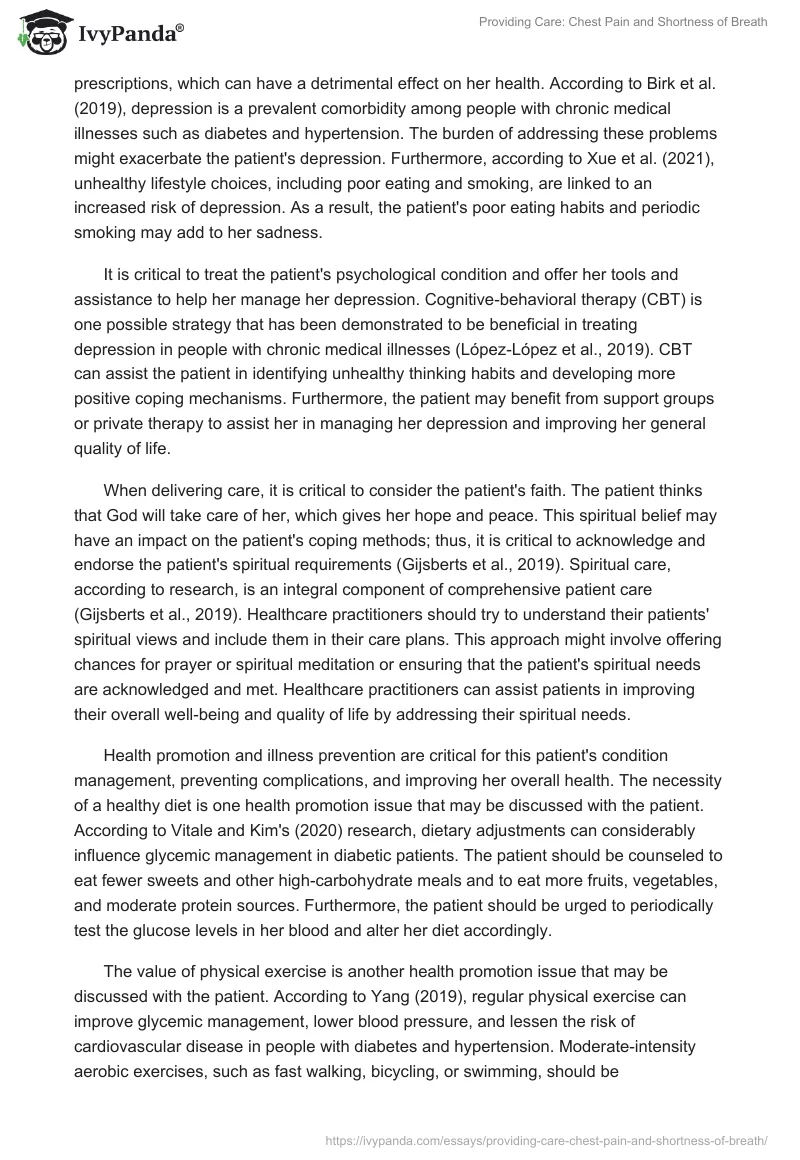Introduction
This case study includes a 69-year-old Puerto Rican Hispanic female who has resided in the United States for 39 years. The critical details of the case involve the fact that the patient has chest pain and shortness of breath, as well as a history of diabetes and hypertension. She confesses to taking her meds on schedule, but she is sometimes too despondent. Moreover, she is concerned about her family and has a habit of drinking a half-bottle of wine when she is unable to sleep. She has terrible eating habits, consumes a lot of sweets, never exercises, and sometimes smokes. The patient’s son, three sisters, their spouses, and many more relatives are in the hospital, praying and socializing, and all family members wear a cross around their necks.
Discussion
Due to the patient’s Hispanic heritage, the cultural ramifications are considerable. The patient’s family is present and supportive, playing an essential part in her treatment. Family members are praying for her, all wearing a crucifix around their necks. As such, the patient’s surroundings correspond to the findings about the Hispanic culture’s significant emphasis on family and religion (Krause, 2019). While delivering care, it is critical to identify and respect these cultural values and customs. According to Brathwaite (2019), healthcare practitioners should be aware of the importance of family engagement in care. They should make every effort to involve family members in caring for their loved ones whenever feasible. Furthermore, healthcare practitioners must respect the patient’s faith and strive to offer treatment compatible with the patient’s opinions and core principles. This cultural understanding and sensitivity are critical for providing high-quality treatment that fits the requirements and preferences of the patient.
The patient in this case study is depressed, which has a severe psychological impact. She admits to being excessively discouraged at times from taking her prescriptions, which can have a detrimental effect on her health. According to Birk et al. (2019), depression is a prevalent comorbidity among people with chronic medical illnesses such as diabetes and hypertension. The burden of addressing these problems might exacerbate the patient’s depression. Furthermore, according to Xue et al. (2021), unhealthy lifestyle choices, including poor eating and smoking, are linked to an increased risk of depression. As a result, the patient’s poor eating habits and periodic smoking may add to her sadness.
It is critical to treat the patient’s psychological condition and offer her tools and assistance to help her manage her depression. Cognitive-behavioral therapy (CBT) is one possible strategy that has been demonstrated to be beneficial in treating depression in people with chronic medical illnesses (López-López et al., 2019). CBT can assist the patient in identifying unhealthy thinking habits and developing more positive coping mechanisms. Furthermore, the patient may benefit from support groups or private therapy to assist her in managing her depression and improving her general quality of life.
When delivering care, it is critical to consider the patient’s faith. The patient thinks that God will take care of her, which gives her hope and peace. This spiritual belief may have an impact on the patient’s coping methods; thus, it is critical to acknowledge and endorse the patient’s spiritual requirements (Gijsberts et al., 2019). Spiritual care, according to research, is an integral component of comprehensive patient care (Gijsberts et al., 2019). Healthcare practitioners should try to understand their patients’ spiritual views and include them in their care plans. This approach might involve offering chances for prayer or spiritual meditation or ensuring that the patient’s spiritual needs are acknowledged and met. Healthcare practitioners can assist patients in improving their overall well-being and quality of life by addressing their spiritual needs.
Health promotion and illness prevention are critical for this patient’s condition management, preventing complications, and improving her overall health. The necessity of a healthy diet is one health promotion issue that may be discussed with the patient. According to Vitale and Kim’s (2020) research, dietary adjustments can considerably influence glycemic management in diabetic patients. The patient should be counseled to eat fewer sweets and other high-carbohydrate meals and to eat more fruits, vegetables, and moderate protein sources. Furthermore, the patient should be urged to periodically test the glucose levels in her blood and alter her diet accordingly.
The value of physical exercise is another health promotion issue that may be discussed with the patient. According to Yang (2019), regular physical exercise can improve glycemic management, lower blood pressure, and lessen the risk of cardiovascular disease in people with diabetes and hypertension. Moderate-intensity aerobic exercises, such as fast walking, bicycling, or swimming, should be recommended to the patient. Furthermore, the patient should be encouraged to engage in strength training activities to enhance her general health and fitness.
Conclusion
In conclusion, the patient’s cultural, psychological, and spiritual consequences must be considered while providing care. The patient’s family is very involved in her treatment, and her faith gives her hope and comfort. Furthermore, by addressing these health promotion themes, the patient can enhance her general health and more successfully manage her diabetes and hypertension. It is critical to offer the patient the resources and assistance she needs to achieve these lifestyle changes and include her family members in the process to ensure she has a robust support system.
References
Birk, J. L., Kronish, I. M., Moise, N., Falzon, L., Yoon, S., & Davidson, K. W. (2019). Depression and multimorbidity: Considering temporal characteristics of the associations between depression and multiple chronic diseases. Health Psychology, 38(9), 802–811. Web.
Brathwaite, B. (2019). Diversity and cultural awareness in nursing practice. SAGE Publications.
Gijsberts, M., Liefbroer, A. I., Otten, R. H. J., & Olsman, E. (2019). Spiritual care in palliative care: A systematic review of the recent European literature. Medical Sciences, 7(2), 25. Web.
Krause, N. (2019). Religion and health among Hispanics: Exploring variations by age. Journal of Religion & Health, 58(5), 1817–1832. Web.
López-López, J., Davies, S. W., Caldwell, D. M., Churchill, R., Peters, T. J., Tallon, D., Dawson, S., Wu, Q., Li, J., Taylor, A., Lewis, G., Kessler, D. A., Wiles, N. J., & Welton, N. J. (2019). The process and delivery of CBT for depression in adults: a systematic review and network meta-analysis. Psychological Medicine, 49(12), 1937–1947. Web.
Vitale, R., & Kim, Y. (2020). The effects of intermittent fasting on glycemic control and body composition in adults with obesity and type 2 diabetes: A systematic review. Metabolic Syndrome and Related Disorders, 18(10), 450–461. Web.
Xue, Y., Lu, J., Zheng, X., Zhang, J., Lin, H., Qin, Z., & Zhang, C. (2021). The relationship between socioeconomic status and depression among the older adults: The mediating role of health promoting lifestyle. Journal of Affective Disorders, 285, 22–28. Web.
Yang, Y. (2019). An overview of current physical activity recommendations in primary care. Korean Journal of Family Medicine, 40(3), 135–142. Web.


